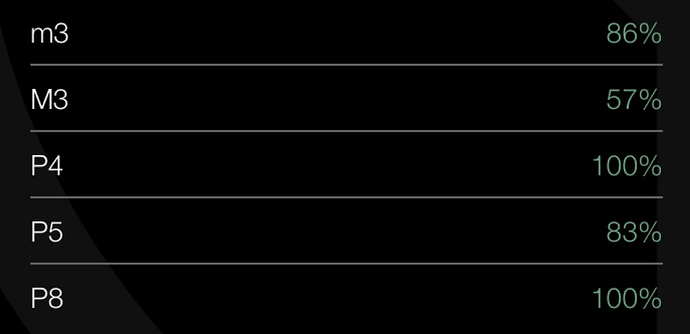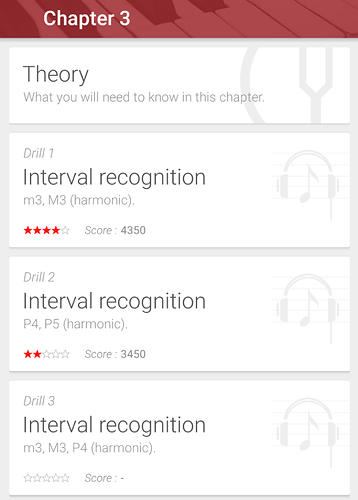I have that app on my Android phone as well. It’s quite handy for a free app.
It’s hard for me to distinguish the P8 from the m3. I get them right only about 80% of the time.
It took me a long time to get past that m3/M3/P8 level too. I didn’t expect it to be nearly as hard as it was!
@tamaraster that’s the level I am on right now… 
Finally passed this one as well… I’m no longer completely deaf!
Seems to be the end of my ear training career though, because the next chapter is harmonic intervals, and it’s just impossible.
you can do it
I got stuck there too 
How far have you got? I can’t even get past m3/M3 (only started today though).
I answer m3 to everything that sounds crap and M3 to everything that sounds ok, but as I keep hearing more m3’s my ears start getting used to them and they no longer sound crap, and then everything starts sounding the same and I’m just stabbing in the dark…
The key is to pick a song that starts with each interval, and always sing the interval before you guess. My song for m3 is Greensleeves (aka “What Child Is This”) and for M3 I use Kumbaya, but there are lists online to help you find songs that work for you.
Then you hear the interval, sing the interval, and try to hear whether you are singing Greensleeves or Kumbaya, for example. Even if you think you can’t sing or match pitches singing, you will get better faster this way, plus get better at singing.
Yes that worked for the melodic trainings, but harmonic is a whole different story (for me at least), because the notes are being played all at once, not in sequence
The only thing that worked for me with the harmonic ones was to sing both notes, then use the technique above, then if I was wrong, listen to the two chord notes that you can get by pressing it again in there and see how wrong I was in my singing. I got a little bit better but not enough to progress before I gave up. I think I got m3/M3 and then gave up. I should go back to it!
I have the worst time in identifying M3 interval.
I mix it with P5, all the freaking time and I think I know why.
because believe it or not, I havent internalised ANY of the reference songs I find on the net.
cries
Major 3rd? I’d think that one wouldn’t be too bad, since it’s the basis of an arpegiated major chord. I really don’t have a good ear, but I have spent a lot of time in church choir, so if you’re exposed to it enough you pick it up. We used to sing intervals: Sing the numbers like Josh calls them out sometimes: 1 - 3 - 5 -3…etc.
I know but still, I hear it for a perfect fifth around 40% of the times.
shrug
If you have access to a piano, try this:
Play a major chord, like C Major: C-E-G. C is the 1, E is the 3, and G is the 5.
Arpegiate it and sing the numeral: 1 (playing C), 3 (playing E), and 5 ( playing G), so,
you play Chord,then the notes C, E, G, but your sing 1, 3, 5.
Then rinse and repeat with another chord, say D-Major, and on you go ascending or random. Intervals are the same.
After a while, you can sing 1-3-5 with the proper intervals. You can take the first tone in your exercise, and see if the second tone fits the template. Does it sound like a 3 or a 5? It’s been a while since I’ve done it, but I remember now: 1-3-5-3-4-2-1. Sometime an octave is thrown in 1-3-5-3-4-2-1(octave).
Never got to doing minor chords or anything advanced like that. I would image there’s something clever to sing for the flat-3. I just don’t know what it would be, but if someone has ever heard of ear training in this manner maybe they could chime in.
Hm I have an old keyboard somewhere, not anything fancy but it was decent back in its day. I might need to try your approach.
So 1-3-5 is M3 and P5; you made hours of theory so easy to me.
I will start with Cmaj and then if and when I master it I will keep doing other chords too. So when I do ANY chord, the 1-3-5 is always M3 and P5?
Thank you for the help, you are awe-some!
1-3-5 in the major scale is 1, M3, P5.
1-3-5 in the natural minor scale is 1, m3, P5.
Other modes vary by mode.
However, it’s more helpful to think of the m3 and M3 as intervals, not discrete notes. If you pick a root note, then two whole steps up is always a M3 interval, and a whole step and a half step up is always a m3 interval.
And any M3 interval plus a m3 interval is a P5 interval from the original note. Magic 
Pick any note, go up a M3 or m3 to get the major or minor third, and then go up the m3 or M3 interval (respectively) to get the perfect 5.
root + m3 interval = minor third
root + M3 interval = major third
root + M3 + m3 intervals = perfect fifth
Correct, because to construct any major cord, the intervals are exactly the same. If you have the first note, sing “One”…then “Three” then “Five” If second tone you are wondering about matches the M3 or the P5…there you go.
Again, I just don’t know how to sing a minor third. You want to associate the number with the interval, so a minor third shouldn’t be a “Three…” or at least I wouldn’t want it be. I never had an application in which to learn minor intervals…
So, to do a minor chord, maybe sing “One, FlatThree, Five?” I dunno, maybe there’s a better way.
Sing Three for major 3rd and TREE for minor 3rd.
Idk, just thought of it now, never tried it
I love the “tree” thing, for real

